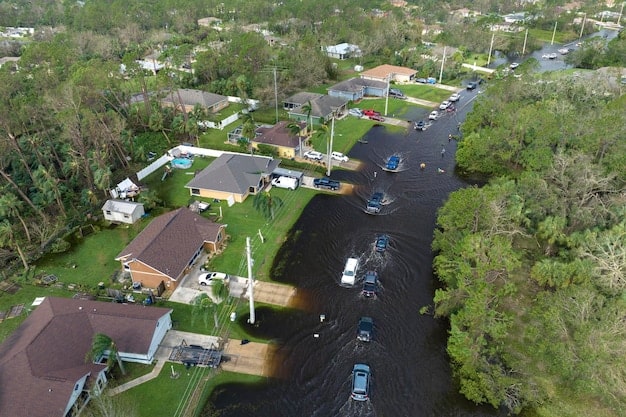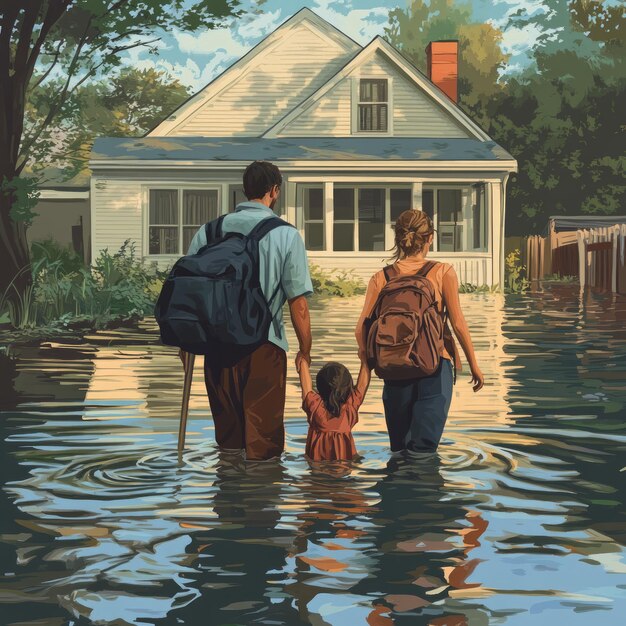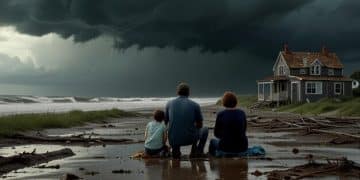Understanding Flash Flooding: Risks, Safety, and Evacuation

Flash floods, characterized by their rapid onset and destructive force, pose significant risks to life and property, necessitating a thorough understanding of their dangers, effective safety protocols, and clear evacuation procedures for community resilience and individual protection.
Understanding the Risks of Flash Flooding: Safety Tips and Evacuation Procedures is paramount for anyone living in or traveling through areas susceptible to sudden, intense rainfall. These powerful natural phenomena can turn a sunny day into a life-threatening scenario within minutes, requiring immediate awareness and preparedness. This comprehensive guide will equip you with vital knowledge to protect yourself and your loved ones.
The Nature of Flash Floods: Unpredictable and Destructive
Flash floods are among the most dangerous natural disasters, notorious for their rapid onset and devastating power. Unlike slower-developing river floods, flash floods erupt quickly, often with little warning, transforming normally dry areas or small streams into raging torrents. This suddenness is what makes them exceptionally hazardous, demanding immediate and decisive action.
Understanding the fundamental mechanics behind flash floods is key to appreciating their danger. They typically occur when intense rainfall over a short period overwhelms the drainage capacity of an area. This can be exacerbated by various geographical and environmental factors, turning what seems like a standard rainstorm into a catastrophic event. The speed at which water rises and the force with which it moves can sweep away vehicles, destroy infrastructure, and endanger lives.
Causes and Contributing Factors
Several elements converge to create the conditions ripe for a flash flood. Identifying these factors helps in recognizing potential threats. Urbanization, for instance, replaces natural ground cover with impervious surfaces like concrete and asphalt, preventing water absorption and increasing runoff.
- Intense Rainfall: Heavy downpours, often from slow-moving thunderstorms or tropical cyclones, are the primary trigger.
- Topography: Steep terrain, narrow canyons, and dry creek beds can funnel water rapidly, concentrating its force.
- Soil Saturation: Ground already saturated from previous rainfall has reduced capacity to absorb more water.
- Burn Scars: Areas recently affected by wildfires can become hydrophobic, repelling water and increasing runoff.
Beyond these natural and man-made elements, localized conditions play a crucial role. Even a seemingly minor downpour on a saturated hillside can unleash a deluge downstream. Awareness of these contributing factors is the first step in preparing for and mitigating the impact of these unpredictable events.
The destructive potential of flash floods lies not only in the sheer volume of water but also in its velocity and the debris it carries. Mud, rocks, trees, and even vehicles can be swept along, becoming deadly projectiles. This combination of speed, volume, and debris makes them incredibly effective at causing widespread damage to infrastructure, homes, and natural environments, posing a significant challenge for emergency responders and affected communities alike.
Identifying Flash Flood Risks: Recognizing Warning Signs
Recognizing the warning signs of a potential flash flood is crucial for early response and safety. While official alerts are vital, individual awareness of environmental indicators can provide precious extra time. The perception that flash floods only happen in visually dramatic settings is a dangerous misconception; they can strike anywhere, from bustling urban centers to remote wilderness.
One of the most immediate indicators is a sudden and dramatic change in water levels, particularly in small streams, creeks, or dry washes. Even if it’s not raining where you are, rapidly rising water can signal heavy rainfall upstream. Observing changes in water clarity can also be a tell-tale sign; clear water turning muddy and turbulent indicates significant runoff.
Weather Patterns and Environmental Cues
Monitoring local weather conditions and understanding the specific vulnerabilities of your area are paramount. Weather alerts issued by authorities, such as the National Weather Service in the US, should always be taken seriously. However, even without official warnings, certain environmental cues can signal impending danger.
- Persistent Heavy Rain: Multi-hour downpours or repeated thunderstorms over the same area.
- Rising Water: Any sudden increase in stream or river levels, especially after heavy rain.
- Muddy Water: Clear streams turning opaque and brown, indicating significant erosion upstream.
- Roaring Sounds: A low, rumbling sound can indicate fast-moving water and debris approaching.
Beyond these immediate observations, understanding your local topography is vital. Areas at the bottom of hills, in valleys, or near drainage channels are inherently more susceptible. Camping near riverbeds or dry washes, especially during the rainy season, carries a significant inherent risk. Always be alert to the sounds of nature, as unusual noises can often precede a flood.
Furthermore, pay attention to the news and local emergency broadcasts during periods of heavy rain. These sources provide critical, real-time information that can guide your decisions. The combination of official alerts, personal observation of environmental cues, and an understanding of your surroundings forms a robust framework for identifying flash flood risks and acting promptly. Never underestimate the speed and force of water, as it can be deceptive in its initial appearance but rapidly escalate into a life-threatening situation.
Essential Flash Flood Safety Tips: Before and During
Preparedness is the cornerstone of safety when facing the threat of flash floods. Taking proactive steps long before a storm hits, and knowing how to react during the event, can significantly reduce risks and save lives. This section outlines critical safety measures for both pre-event planning and in-the-moment response, emphasizing that complacency is the greatest danger.
Before a flash flood even becomes a remote possibility, families and communities should establish clear communication plans and emergency kits. Knowing what to do, where to go, and how to contact loved ones can alleviate panic and streamline evacuation efforts when time is of the essence. It’s not enough to hope for the best; active preparation is an absolute necessity in vulnerable areas.
Pre-Flood Preparation: Building Resilience
Proactive measures are your first line of defense. Start by understanding your local flood risk through FEMA flood maps and community hazard assessments. Create an emergency plan that includes designated meeting points, emergency contacts, and evacuation routes. This plan should be practiced periodically, especially with children, to ensure everyone knows their role and the steps to take.
- Emergency Kit: Assemble a kit with water, non-perishable food, first-aid supplies, medications, flashlight, batteries, radio, and a whistle.
- Important Documents: Keep copies of essential documents (IDs, insurance policies) in a waterproof bag.
- Communication Plan: Establish how family members will contact each other if separated, including out-of-state contacts.
- Home Protection: Consider installing sump pumps, checking drainage systems, and elevating valuable property.
During a flash flood, the dangers escalate rapidly. The primary rule is never to drive or walk through floodwaters. Just six inches of moving water can knock an adult off their feet, and twelve inches can carry away most cars. The water’s depth can be deceptive, and the road beneath may be washed away, hiding debris or hazardous materials. “Turn around, don’t drown” is more than a slogan; it’s a life-saving directive which cannot be overstated in its importance. The risk is simply too high to gamble with. Always seek higher ground
immediately.

If you find yourself caught in a flash flood while at home, move to the highest possible ground within your dwelling. Avoid attics unless there is an exit point to the roof, as you could become trapped. If trapped outside, climb to a high, stable location like a tree or rooftop. Remember that electricity can pose a severe hazard in floodwaters; never approach downed power lines. These immediate actions are crucial for survival, highlighting the need for calm and decisive thinking under pressure.
Evacuation Procedures: When and How to Leave Safely
Evacuation is a critical component of flash flood safety, representing the final and most urgent step when lives are at stake. Knowing when to evacuate and how to do so safely is paramount, as conditions can deteriorate rapidly, cutting off escape routes and trapping individuals. This section focuses on the protocols and considerations for timely and effective evacuation during a flash flood event.
The decision to evacuate is rarely taken lightly, but in the face of flash flooding, hesitation can have dire consequences. Always heed official evacuation orders from local authorities. These orders are issued based on expert assessment of current and projected conditions, indicating an imminent threat to life and property that cannot be managed by sheltering in place. Ignoring such directives places not only yourself but also emergency responders at unnecessary risk.
Official Warnings and Strategic Departure
Official warnings, typically disseminated through emergency alerts, local news, and community notification systems, provide critical guidance. These alerts often specify evacuation zones and designated routes, which should be followed precisely to avoid hazards.
- Heed Official Orders: Always evacuate immediately if ordered by authorities. Do not wait for conditions to worsen.
- Designated Routes: Follow recommended evacuation routes. These are planned to be the safest and highest ground.
- Travel Safely: Avoid flooded roads and utilize alternative routes. Never drive or walk through moving water.
- Communicate Your Plan: Inform family and friends of your evacuation plans and expected destination.
Before leaving, if time permits, turn off utilities like gas and electricity at the main switches to prevent damage and reduce fire risk when floodwaters approach your home. Secure outdoor items that could be swept away or become dangerous projectiles. Even small actions like these can contribute to greater safety and minimize post-flood recovery efforts.
Evacuation should be a streamlined, organized process, not a panicked rush. Keeping a “go bag” prepared with essentials—medications, important documents, a change of clothes, and critical supplies—can save valuable time. Moving quickly, yet calmly, and prioritizing safety over material possessions is the mantra for successful flash flood evacuation. The goal is to reach safe, higher ground and remain there until authorities declare the area safe for return, ensuring that lives are protected above all else.
Post-Flood Recovery: Assessing Damage and Rebuilding
The aftermath of a flash flood is often a scene of considerable devastation, requiring careful assessment and a systematic approach to recovery. Returning home prematurely or mishandling damaged property can lead to further risks, including structural collapse, electrical hazards, and exposure to contaminants. This phase is as critical as preparation and evacuation, demanding a blend of patience, caution, and adherence to safety guidelines.
Before re-entering your home or affected area, wait for official clearance from local authorities. Floodwaters can mask dangers such as compromised foundations, gas leaks, and downed power lines, which are not immediately visible. The impulse to return quickly is understandable, but personal safety must remain the absolute priority to prevent secondary injuries or fatalities during the recovery process.
Safety and Structural Considerations
Once deemed safe to return, proceed with extreme caution. Wear protective clothing, including sturdy shoes, gloves, and a mask, to guard against cuts, contaminated water, and airborne particles. Document all damage thoroughly with photos or videos for insurance claims before beginning any cleanup or repairs. This documentation is crucial for a smooth and comprehensive claims process.
- Safety First: Do not enter damaged buildings until inspected by a professional. Beware of hidden structural damage.
- Utility Checks: Ensure gas, water, and electrical systems are checked by qualified technicians before turning them back on.
- Hazard Identification: Watch for snakes, displaced wildlife, and other pests in flood-damaged areas.
- Hygiene: Practice strict hygiene during cleanup due to potential water contamination.
Cleanup efforts should prioritize drying out flooded areas as quickly as possible to prevent mold growth, which can pose significant health risks. Remove all wet items, including carpeting, furniture, and drywall that has been soaked. Disinfect surfaces that came into contact with floodwaters using an appropriate sanitizer, following chemical instructions carefully.

Reaching out to local support services and disaster relief organizations is also vital during recovery. They can offer assistance with housing, financial aid, and emotional support. The rebuilding process, both physical and emotional, can be extensive and challenging, but a structured approach and community support can help alleviate the burden and foster resilience in the face of such overwhelming natural events.
Technological Advancements in Flood Prediction and Response
Recent advancements in technology are revolutionizing how we predict, monitor, and respond to flash floods, offering new layers of protection and enabling more timely and effective interventions. From sophisticated forecasting models to real-time data collection, these innovations are improving our capacity to mitigate the impacts of these rapid-onset disasters. While human vigilance remains essential, technology now provides powerful tools to enhance our preparedness and response capabilities.
Enhanced meteorological forecasting models, powered by supercomputers and vast datasets, can now simulate atmospheric conditions with unprecedented accuracy. This allows meteorologists to identify rainfall patterns and potential flood triggers further in advance, providing crucial lead time for warnings and preparation. These models integrate data from satellites, radar, and ground-based sensors, painting a comprehensive picture of evolving weather systems.
Real-Time Monitoring and Communication Tools
Beyond prediction, real-time monitoring systems are providing critical data during an event. Networks of stream gauges, weather stations, and soil moisture sensors transmit continuous updates, allowing emergency managers to track water levels and flow rates as they rise. This real-time visibility enables more precise and localized warnings, directing resources where they are most needed.
- Advanced Radar Systems: Provide detailed rainfall intensity and movement, allowing for localized flash flood warnings.
- IoT Sensors: Networks of sensors in rivers and floodplains deliver immediate water level data to monitoring centers.
- AI and Machine Learning: Algorithms analyze vast datasets to identify flood patterns and predict affected areas with higher accuracy.
- Satellite Imagery: Offers broad-scale and post-event assessment of flooded areas, aiding in damage assessment and recovery planning.
Communication technologies have also seen significant strides. Emergency alert systems, including Wireless Emergency Alerts (WEA) for mobile phones, deliver time-sensitive flash flood warnings directly to affected populations. Social media platforms and community notification apps facilitate the rapid dissemination of information, allowing for two-way communication during emergencies.
Drones are increasingly being used for rapid damage assessment in inaccessible areas, providing immediate visual data for first responders. Robotics can assist in searching for survivors in dangerous conditions, reducing risk to human rescue teams. These technological integrations, from sophisticated predictive analytics to on-the-ground responsiveness, are transforming flash flood management, making communities safer and more resilient against these formidable natural forces. The continuous evolution of these tools holds promise for even greater protection in the years to come.
Community Resilience and Future Preparedness
Building community resilience is a proactive, long-term strategy essential for minimizing the human and economic toll of flash floods. It extends beyond individual preparedness, encompassing the collective efforts of local governments, emergency services, businesses, and residents to adapt, withstand, and recover from these increasingly frequent and intense events. A truly resilient community views flash floods not just as individual disasters but as shared challenges requiring unified responses and sustainable solutions.
Local governments play a pivotal role in fostering this resilience by investing in robust infrastructure, such as improved drainage systems, protective levees, and early warning networks. Urban planning considerations, like integrating green infrastructure that promotes natural water absorption (e.g., permeable pavements, rain gardens), can significantly reduce flash flood risk in developed areas. These structural and environmental adaptations form the physical backbone of community resilience, protecting properties and lives.
Education and Collaborative Action
Equally important is community education and engagement. Public awareness campaigns on flash flood risks, safety tips, and evacuation procedures empower residents to make informed decisions. Workshops, drills, and accessible information resources ensure that every member of the community, from schoolchildren to seniors, understands their role in preparedness and response.
- Public Awareness Campaigns: Educate residents on local flood risks, warning signs, and safety protocols.
- Community Flood Drills: Practice evacuation routes and emergency procedures to ensure readiness.
- Volunteer Networks: Establish and train local volunteer groups for assistance during and after flood events.
- Inter-Agency Coordination: Foster strong partnerships between emergency services, local government, and non-profits.
Collaboration among various stakeholders—emergency management agencies, public works departments, healthcare providers, and community organizations—is fundamental. Establishing clear lines of communication and coordinated response protocols ensures a seamless and efficient reaction during a flash flood. Post-event, this collaboration continues into recovery efforts, pooling resources for effective cleanup, rebuilding, and support for affected residents.
Future preparedness also involves adapting to the changing climate, which is projected to increase the frequency and intensity of extreme rainfall events. This includes re-evaluating flood plain maps, updating building codes to account for higher flood levels, and integrating climate change projections into long-term infrastructure planning. By combining physical infrastructure, public education, collaborative governance, and climate adaptation, communities can build a robust shield against the unpredictable and destructive force of flash floods, ensuring a safer and more sustainable future for all residents.
| Key Aspect | Brief Description |
|---|---|
| 🚨 Rapid Onset | Flash floods strike quickly with little warning, driven by intense rainfall. |
| 🚗 Safety Rule | Never drive or walk through floodwaters; “Turn around, don’t drown.” |
| 🗺️ Evacuation | Heed official orders & follow designated routes to higher ground. |
| 🛠️ Recovery | Wait for clearance before returning; document damage & prioritize safety in cleanup. |
Frequently Asked Questions About Flash Floods
▼
The primary distinction lies in their speed of onset. Flash floods occur rapidly, often within minutes or a few hours of heavy rainfall, and are characterized by intense, localized bursts of water. Regular floods develop more slowly, typically over days or weeks, as rivers or large bodies of water overflow their banks due to prolonged rain or snowmelt.
▼
Surprisingly little. As little as six inches of fast-moving water can knock an adult off their feet. Twelve inches can sweep away most cars, and two feet can carry away larger vehicles like trucks and SUVs. The danger isn’t just depth, but the force of moving water, which can be deceivingly powerful.
▼
If your vehicle stalls in floodwaters, abandon it immediately and seek higher ground. Do not attempt to drive through flooded roads, as the roadbed may be washed out beneath the water, or the current may be too strong to control your vehicle. Prioritize your safety over your vehicle’s. “Turn around, don’t drown” applies explicitly here.
▼
Only if your attic has a way to get out onto the roof. While going to the highest point in your home is generally advised, attics can become death traps if floodwaters rise too high and trap you inside. If you climb into your attic, ensure there’s an accessible exit to the roof so you can be rescued if necessary.
▼
Protecting your home involves several steps: ensure your gutters and drains are clear, consider landscaping that directs water away from your foundation, installing a sump pump, elevating valuable appliances and utilities, and keeping an emergency supply kit ready. Review your flood insurance coverage regularly, as standard homeowner’s policies typically do not cover flood damage.
Conclusion
Navigating the inherent dangers of flash flooding requires a proactive, multi-faceted approach encompassing awareness, preparation, and decisive action. By understanding the rapid, destructive nature of these events, recognizing critical warning signs, and adhering to established safety and evacuation procedures, individuals and communities can significantly enhance their resilience. From assembling robust emergency kits to heeding official directives and leveraging technological advancements in prediction, every step contributes to saving lives and minimizing damage. The journey from preparedness to post-flood recovery demands vigilance and collaboration, reinforcing the critical message that foresight and informed choices are the most powerful tools against the unpredictable force of water. Ultimately, continuous learning and adaptation are key to building communities that can withstand, and ultimately thrive, despite the escalating challenges posed by extreme weather events.





